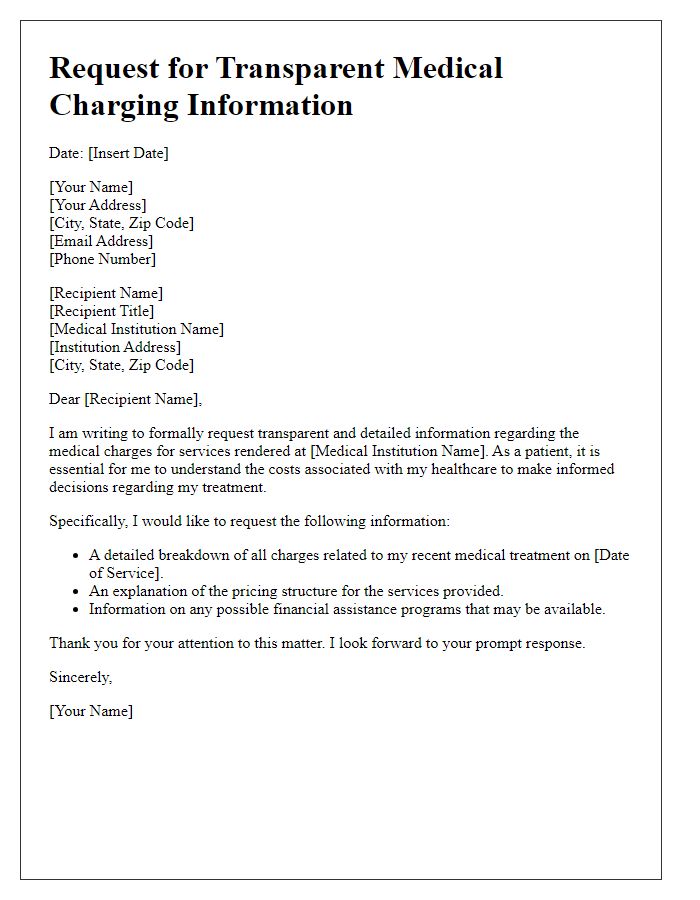Are you puzzled by your medical bill and looking for clarity? Understanding your medical charges can be a daunting task, especially with all the intricate details involved. In this article, we'll guide you through crafting a thoughtful letter to request a detailed breakdown of those charges, ensuring you have all the necessary information at your fingertips. So, let's dive in and empower you to take control of your medical expenses!

Clear Identification of Patient and Services Rendered
A detailed request for a breakdown of medical charges provides essential information regarding the patient and the services rendered. Patient identification includes full name (e.g., John Smith), date of birth (e.g., January 1, 1980), and medical record number (e.g., MRN 123456). This ensures accurate processing of the request. The services rendered should outline specific treatments or procedures received, such as consultations, surgeries, diagnostic tests, or medications, accompanied by the corresponding dates (e.g., surgery performed on March 15, 2023) and the names of healthcare providers involved (e.g., Dr. Jane Doe). Clarification on various charges, such as facility fees, medication costs, and consultation fees, is crucial for transparency. Lastly, requesting itemized statements with codes (e.g., CPT codes for procedures) helps ensure a comprehensive understanding of the total medical expenses incurred during the treatment period.
Specific Request for Detailed Itemization
Requesting a breakdown of medical charges requires clarity on key aspects such as date of service, healthcare provider, and specific treatments received. Patients who visit healthcare facilities, such as hospitals or outpatient clinics (e.g., Mercy Hospital in Springfield or City Health Clinic), may encounter itemized bills that reflect various charges, including consultation fees, lab tests (like blood work or imaging services), and medications administered. Details such as the date of service (e.g., October 1, 2023) and account number also help in efficiency. Additionally, understanding the insurance adjustments can clarify total out-of-pocket expenses. By requesting a detailed itemization, patients can ensure transparency in billing and potentially identify discrepancies or errors in charges.
Inclusion of Billing Codes and Descriptions
Patients often seek detailed statements from medical providers regarding charges incurred during treatment. A clear breakdown of medical charges, including specific billing codes and descriptions, provides transparency. Billing codes, such as CPT (Current Procedural Terminology) codes, represent the healthcare services and procedures provided, while ICD (International Classification of Diseases) codes categorize the diagnosis. An itemized statement allows patients to understand costs associated with individual treatments, lab tests, medications, and consultations. Such clarity not only helps in verifying insurance claims but also assists in budgeting for future medical expenses. Having this detailed information aids in resolving discrepancies and ensures accurate financial planning for ongoing healthcare needs.
Statement of Purpose and Use
Requesting a breakdown of medical charges is crucial for understanding healthcare expenses clearly. Comprehensive medical bills often include services rendered, dates of treatment, and individual charges for procedures. Accurate breakdowns allow patients to verify insurance coverage and identify potential discrepancies. Clear itemization of charges helps in budgeting and financial planning, essential for patients facing high medical costs. Additionally, obtaining this information ensures transparency in medical billing, promoting trust between healthcare providers and patients, and aiding in the negotiation process should discrepancies arise. Understanding these charges supports patients in making informed decisions regarding their healthcare.
Contact Information for Follow-Up Communication
Requesting a detailed breakdown of medical charges is essential for clear understanding of expenses incurred during medical treatment at facilities like General Hospital. Patients often desire clarity regarding individual costs, including itemized fees for services rendered, such as consultations, laboratory tests, imaging (e.g., X-rays, MRIs), and medication. This request typically includes personal information, such as patient name, date of service, and account number, allowing medical billing departments to locate records efficiently. Billing transparency facilitates financial planning, ensuring patients can verify insurance coverage and out-of-pocket expenses. Moreover, understanding specifics aids in addressing any discrepancies found in billing statements.
Letter Template For Requesting Breakdown Of Medical Charges Samples
Letter template of solicitation for comprehensive medical charges breakdown













Comments